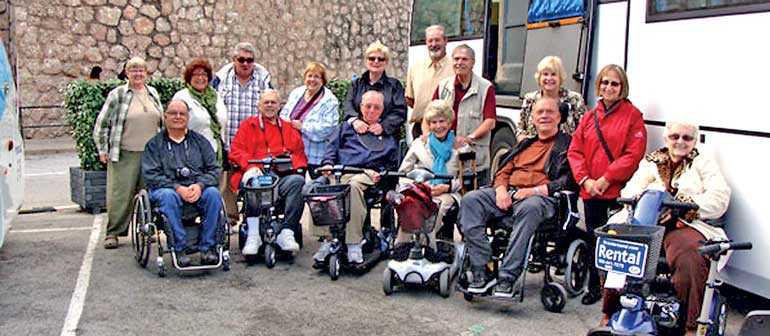Wednesday Jul 02, 2025
Wednesday Jul 02, 2025
Tuesday, 8 January 2019 00:00 - - {{hitsCtrl.values.hits}}

A lucrative new profit source for Sri Lanka
There is an increasingly strong financial incentive for those involved in tourism to make their facilities safe and accessible equally to everyone.
For different reasons – including rapid ageing, numerous debilitating medical conditions (that often go unnoticed), accidents, convalescence and even being pregnant – nearly 25% of the world’s travelling population find their physical and sensory abilities of visible or hidden nature restricted to a significant level for a short time or for a long time, often suddenly. It could happen even during a flight, on embarkation or over the stay here.
More people use wheelchairs or frames or sticks to move safely with ease. They not only form the world’s biggest travelling minority, but represent a lucrative huge market segment for Sri Lanka Tourism which today remains vastly under-served. Surprisingly, these people are eager to travel with all three elements of an ideal travel customer: Desire to travel, time to travel and enough means to travel.
What has only recently been researched is the high purchasing power and encouraging travel behaviour of these travellers who live with restricted mobility. They are an overlooked growth market but their spending potential remains untapped due to poor infrastructure facilities and absence of the right marketing to earn their business.
Increasing number of destinations (Viet-Nam included) stand to profit greatly by systematically targeting this growing market of people with limited mobility and those over 60 years.
Why make facilities accessible equally to everyone?
(i). Many people in this increasing group, especially the over 60s, are not tied to school vacations, summer holidays for their holiday taking. Therefore countries that focus on accessible tourism concepts – unlike Sri Lanka – do not have what we call ‘the lean period’ or ‘seasonality’, where tourist arrivals drop during certain months.
(ii). They have the time, mind and money to take more holidays, and often come at all-times of the year, even out of season. In fact they report they would double their travel if appropriate facilities and services were offered. This means more hotel stays ‘if hotels invest to make suitable accommodation available’.
(iii). Senior citizens and people with limited mobility/vision usually travel with able-bodied friends, family or carers and thereby numbers multiply many fold to bring additional revenue.
(iv). They frequently book in advance, often returning on a regular basis once they find the right facilities, and promote the industry by word-of-mouth, amongst a powerful network of travellers with dis-Abilities.
(v). Online ratings and reviews by booking engines like Agoda.com – which take into account accessible facilities – are increasingly relied upon by more and more international travellers.
(vi). Hotels that cater to this resilient set of customers will gain loyal patrons who tend to spend little more than the average customer, stay just a little longer and usually bring one or two more with them.
It’s now or never
People with restricted ability represent a large and ever growing untapped lucrative market, for both business and leisure travel.
Sri Lanka, which has so much diversity to offer untapped lucrative groups of tourists for both business and leisure travel, still, has a good opportunity far to surpass its ever growing competition by (re-)building its tourist resources using the best practices of inclusive tourism and enforcing total compliance with court orders and gazetted design standards and safety measures.
Remember: The inclusivity of ‘people with restricted mobility through design’ creates easy and safe access opportunities for everyone – with or without dis-Ability. It is a win-win situation for all!
As we see a proliferation of new buildings and new hotels as part of several mega-development programs, Sri Lanka, still, has a not to be missed opportunity far to surpass its competition by (re-)building its tourist resources using the best practices of inclusive tourism for all.
Accessible tourism
It is all about ‘easy and safe access’ to buildings: Parts of hotels, facilities and services (especially to correct information, appropriate transport and rooms-toilets-and-restaurants) along with well trained staff having positive and solicitous attitudes but never attending with condescension, especially towards travellers with restricted mobility.
Providing quality service to all customers – especially at busy times – is a high and personally demanding standard. To sustain it requires professional skills, positive attitudes, commitment and a solid business plan.
Hotel guests are sensitive to whether they are being ‘truly’ welcomed or merely accommodated. Travellers with limited mobility – especially those using wheelchairs – consistently rate the attitudes and skills of staff as far more important in their travel experiences – shared widely on the internet and by word of mouth – even above architect.
Buildings send vital messages
With accessible tourism everyone invariably benefits. Safety to life – especially when you are on tour – is not negotiable or to be compromised. Hence the architect is equally important, as the right design guarantees a welcome to all.
Inclusive designs of built environments and the awareness of them created over the internet enables the world to make concrete prior decisions about who is welcome by design. If they are absent, that signals, not so subtly, who is unwelcome!
According to the World Bank the cost of including accessibility features at the time of construction is minimal. Making facilities accessible adds less than 1% to construction costs. We are a country much dependent on tourism, but we are yet to position our hotels in line with the rest of the world. Although complying with SC Orders is mandatory, Tourism Ministry violates this legal obligation to Gazette it in not adding it to the list of mandatory criteria!
Contrary to popular belief, it is not a need that can be postponed further or a financial burden to build facilities that are easily and safely accessible equally by everyone.
According to the World Bank the cost of including accessibility features at the time of construction is minimal. Making facilities accessible adds less than 1% to construction costs.
However, designing for inclusion is a highly responsible task involving money, time and effort. It requires in depth understanding of its intricacies acquired with wide practical knowledge on this subject. It cannot be accomplished just by reading text books.
Open your eyes
We are a country much dependent on tourism, but we are yet to position our hotels in line with the rest of the world. Does a website of any hotel in Sri Lanka provide technical and photographic descriptions of the facilities they possess – especially concerning toilets, rooms, restaurants and wash facilities in particular – for the world’s largest minority of travelling population – those with limited mobility, ambulant and those using wheelchairs included? Sadly not!
How many main city hotels, renovated and even ‘new’, prevent the marginalisation of non-ambulatory tourists by providing safe access to washrooms and toilets complying with design standards? Hardly any; but they are still continuing to be awarded 4 and 5 Stars!
Full safe and easy access to all parts of hotels based on ‘Design for All’, should be an integral feature of a destination’s immediate planning and investments in modernisation of infrastructure, not in bits and pieces.
Have we missed the bus again?
The new gazette notification No. 1963/28 dated 20 April 2016, makes it mandatory for all tourist hotels registered under the Sri Lanka Tourism Development Authority (SLTDA) to be classified as star class tourist hotels.
Hotel classification criteria comprise two components: One which is mandatory to reach a particular star class level and another list of optional attributes and requirements.
The Hotel Classification Committee appointed by Sri Lanka Tourism Development Authority continues to fail to recognise – even with this latest revision – the indispensable need for at least 5 and 4 star class levels to comply with accessibility regulations made under the Act No. 28 of 1996 and the subsequent SC Order.
Although complying with SC Orders is mandatory, Tourism Ministry violates this legal obligation to Gazette it in not adding it to the list of mandatory criteria!
No wonder we tragically see the proliferation of new hotels with poor compliance with the accessibility regulations and even an Order of the Apex Court.
Thereby increasing numbers of travelling people find their plans of selecting Sri Lanka as their next destination either for holidaying or business potentially crippled.
(The writer – a paraplegic since 1992 – is the pioneer campaigner for Accessible Tourism Equally for All and possesses over 20 years of wide practical experience as a competent advisor on accessibility. See: goo.gl/tZZsmz.)
Discover Kapruka, the leading online shopping platform in Sri Lanka, where you can conveniently send Gifts and Flowers to your loved ones for any event including Valentine ’s Day. Explore a wide range of popular Shopping Categories on Kapruka, including Toys, Groceries, Electronics, Birthday Cakes, Fruits, Chocolates, Flower Bouquets, Clothing, Watches, Lingerie, Gift Sets and Jewellery. Also if you’re interested in selling with Kapruka, Partner Central by Kapruka is the best solution to start with. Moreover, through Kapruka Global Shop, you can also enjoy the convenience of purchasing products from renowned platforms like Amazon and eBay and have them delivered to Sri Lanka.
Discover Kapruka, the leading online shopping platform in Sri Lanka, where you can conveniently send Gifts and Flowers to your loved ones for any event including Valentine ’s Day. Explore a wide range of popular Shopping Categories on Kapruka, including Toys, Groceries, Electronics, Birthday Cakes, Fruits, Chocolates, Flower Bouquets, Clothing, Watches, Lingerie, Gift Sets and Jewellery. Also if you’re interested in selling with Kapruka, Partner Central by Kapruka is the best solution to start with. Moreover, through Kapruka Global Shop, you can also enjoy the convenience of purchasing products from renowned platforms like Amazon and eBay and have them delivered to Sri Lanka.